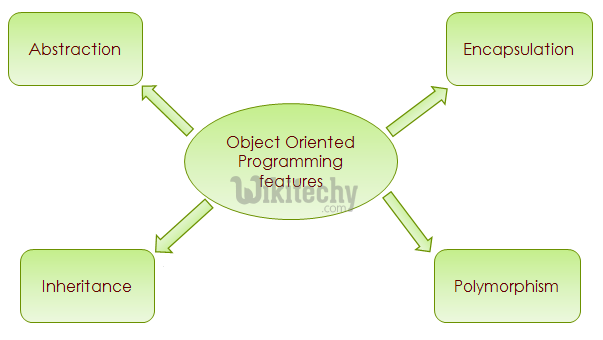python tutorial - OOPs Concepts | Python OOPs Concepts - learn python - python programming
What is Python OOPs Concepts?
- Python is called an "object-oriented programming language".
- You can easily create and use classes and objects in Python.
- This means there is a construct in Python called a class that lets you structure your software in a particular way.
- Using classes, you can add consistency to your programs so that they can be used in a cleaner way. At least that's the theory.
- Object-oriented programming (OOP) is a programming paradigm that uses objects and their interactions to design applications and computer programs.

- Major principles of object-oriented programming system are given below:
- Object
- Class
- Method
- Inheritance
- Polymorphism
- Data Abstraction
- Encapsulation
Object
- Object is an entity that has state and behavior.
- It may be anything.
- It may be physical and logical.
- For example: mouse, keyboard, chair, table, pen etc.
- Everything in Python is an object, and almost everything has attributes and methods.
- All functions have a built-in attribute __doc__, which returns the doc string defined in the function source code.
Class
- Class can be defined as a collection of objects.
- It is a logical entity that has some specific attributes and methods.
- For example: if you have an employee class then it should contain an attribute and method i.e. an email id, name, age, salary etc.
Syntax:
class ClassName:
<statement-1>
.
.
.
<statement-N>Method
- Method is a function that is associated with an object.
- In Python, method is not unique to class instances.
- Any object type can have methods.
Inheritance
- Inheritance is a feature of object-oriented programming.
- It specifies that one object acquires all the properties and behaviors of parent object.
- By using inheritance, you can define a new class with a little or no changes to the existing class.
- The new class is known as derived class or child class and from which it inherits the properties is called base class or parent class.
- It provides re-usability of the code.
Polymorphism
- Polymorphism is made by two words "poly" and "morphs".
- Poly means many and Morphs means form, shape.
- It defines that one task can be performed in different ways.
- For example: You have a class animal and all animals talk. But they talk differently.
- Here, the "talk" behavior is polymorphic in the sense and totally depends on the animal.
- So, the abstract "animal" concept does not actually "talk", but specific animals (like dogs and cats) have a concrete implementation of the action "talk".
Encapsulation
- Encapsulation is also the feature of object-oriented programming.
- It is used to restrict access to methods and variables.
- In encapsulation, code and data are wrapped together within a single unit from being modified by accident.
Data Abstraction
- Data abstraction and encapsulation both are often used as synonyms.
- Both are nearly synonym because data abstraction is achieved through encapsulation.
- Abstraction is used to hide internal details and show only functionalities.
- Abstracting something means to give names to things, so that the name captures the core of what a function or a whole program does.
Object-oriented vs Procedure-oriented Programming languages
| Index | Object-oriented Programming | Procedural Programming |
|---|---|---|
| 1. | Object-oriented programming is an approach to problem solving where computation is done by using objects. |
Procedural programming uses a list of instructions to do computation step by step. |
| 2. | It makes development and maintenance easier. |
In procedural programming, it is not easy to maintain the codes when project becomes lengthy. |
| 3. | It simulates the real-world entity. So, real world problems can be easily solved through oops. |
It doesn't simulate the real world. It works on step by step instructions divided in small parts called functions. |
| 4. | It provides data hiding. so, it is more secure than procedural languages. You cannot access private data from anywhere. |
Procedural language doesn't provide any proper way for data binding so it is less secure. |
| 5. | Example of object-oriented programming languages are: C++, Java, .Net, Python, C# etc. |
Example of procedural languages are: C, Fortran, Pascal, VB etc. |
